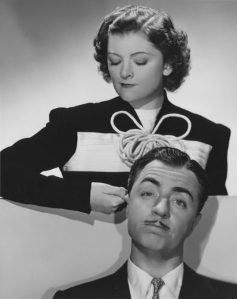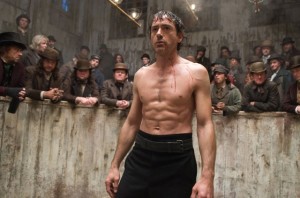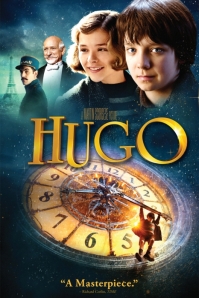
The poster for Windtalkers sends the message that the film’s story is really about the white protagonist.
The film the class is watching this week is Windtalkers, directed by John Woo. We’ll address representations of Native Americans in the film, masculinity, and some things to look for in John Woo’s directing. But first, let’s do a quick overview of the War film genre in Hollywood. We’ll use John Belton’s American Cinema/American Culture as our main resource for discussing the genre and its place in American popular culture.
War films
War films occupy an important place in American cinema. This genre, along with the Western, helps us define ourselves as well as defines us to the rest of the world. These films often show a unified America that does not exist in reality and they often depict the idealized American man–a strong individual with high morals who will fight for his country (and, it is often implied, the underdog).
Belton writes, “The war film mediates our relationship to war, helping to prepare us for it, reconcile us to victory or defeat, and adjust us to its aftermath. The conventions of the war film continue to shape our understanding of real wars–to inspire us, on the one hand, to fight in them and, on the other, to protest against them. Though wars continue to be fought and won or lost on the battlefield, they also continue to be fought and won or lost through their representation on the movie or television screen. Images of war explain why we fight; they stage and restage war’s battles; and they attempt to explain why we won or lost” (182).
The war films made during and shortly after World War II were generally supportive of the American military and our role in the war. These films helped garner support for the war effort or depicted the actions of the soldiers involved as unquestionably heroic. While there might have been occasional references to “war is hell,” the mood is overwhelmingly supportive. The Vietnam war changed that. War films from the early 1970s on, often question American involvement in global wars and the decision making process where young men and women are sent to wars for reasons other than a direct military threat to the U.S.
Belton lists four conventions in American war films:
- the suspension of civilian morality during war (i.e., killing other people is no longer considered murder during war).
- collective goals take precedence over the goals of the individual (i.e., completing the assigned mission is more important than any personal goals).
- there is rivalry between men in predominantly male groups and the objectification of women (i.e., many war films contain sub-themes where recruits compete for the drill sergeant’s favor during boot camp; when women appear in war films, they are often companions for the men when they have leave or are caregivers such as nurses).
- the reintegration of veterans to civilized society (not all war films include this aspect, but the struggle to return to civilian life is a frequent theme in post-Vietnam war films).
Masculinity constructed
In “Men, Masculinity, and Manhood Acts,” Douglas Schrock and Michael Schwalbe discuss how masculinity is developed and studied. They provide an overview of masculinity studies in the late 2oth century and suggest studying how men interact and collaborate to build and reinforce masculine identities.
If you’re not used to thinking of gender as separate from biological sex, it may help to do some thinking about the ways in which gender is socially developed. Most of us are labeled “male” or “female” at birth based on our genitalia. That is our biological sex, and while it seems fairly cut and dry, there are intersex conditions that make even biological designations of male or female unclear—something that seems like an essential marker of identification—”male” or “female”—is not always a reliable or easy categorization to make.
Gender is different from our biological sex. Gender is how we view ourselves (and are viewed by others) as male or female*. Gendering starts early—often before we even make it out of the womb. Parents who find out the sex of their baby often share the news so well-wishers can stock up on pink or blue items. Since we are concentrating on masculinity this week, I’ll write about how social gendering happens with boys; you can think of similar examples of how it works with girls.

A young boy decked out in “Lone Ranger” clothes and a toy gun, circa 1940s. State Archives of Florida, Florida Memory, http://floridamemory.com/items/show/154796
Early on, boys are given “boy toys”—trucks, construction toys, sports equipment, and toy swords and guns. The little boy who dresses up as a fireman or a superhero gets indulgent smiles from strangers. The little boy who slips his feet into mom’s shoes gets scolded even if he has put them on because he thinks they are a neat color or he wants to be an inch taller; adults fear the little boy will “turn gay” by putting on the shoes or playing with his sister’s Easy Bake Oven. (For whatever reason, it is more acceptable in the United States for a girl to show “masculine” traits like assertiveness and interest in “boy” things like sports.)
For American males, anything that smacks of femininity or homosexuality is forbidden and adolescent boys quickly learn to use both femininity and possible gayness as insults to regulate each other’s behavior–i.e, “you throw like a girl!” Boys who do not conform to the expected gender roles are ostracized, sometimes with tragic results.
While gender roles are shifting, there is still a lot of pressure for men to conform to narrow definitions of “acceptable” masculine behavior and presentation. Men in the U.S., are, by and large, expected to be strong, assertive, to objectify women, be rational, keep their emotions in check, etc. The problem with this narrow definition is that it excludes many types of masculinity; it assumes heterosexuality, for example, or leaves out familial cultural roots and their impact.
Many of the ways men define themselves (or are defined by society) is in opposition to the concept of Woman. Why does it seem natural to define something by what it isn’t? Are there other ways might men define themselves that isn’t dependent upon a binary?
In 2010, Esquire Magazine did a poll of American men on a wide range of topics to see how the generations felt about everything from politics to sex. Click here to see how men in their 20s and 50s responded. What might we gather about American men from the survey results? How do the two generations seem similar? Where do they seem divided on what it means to be a man in the U.S. now?
Windtalkers
Windtalkers is a 2002 film directed by John Woo. By the title of the film, we expect to hear the story of the Navajo Code Talkers who served during World War II and kept the Japanese forces from deciphering American radio transmissions. Instead, the film focuses most of the attention on Sergeant Joe Enders (played by Nicolas Cage) and his perception of the mission, including his assignment as a body guard to Private Ben Yahzee (Adam Beach).
Director John Woo uses many parts of the formula found in standard Hollywood war films: a racist soldier, a nurse with a heart of gold, a love-sick soldier, a commander who does everything by the books, a scene where the Navajo solider saves the racist, etc. Woo also presents the Japanese soldiers as a largely faceless enemy, so he can spend more time on the pyrotechnics.
Woo built his name as an action director, so it is not really surprising that the film is actually thin on story, but Windtalkers doesn’t really show his trademark almost balletic action scenes. The hand-to-hand combat is heavy on bullets, blood, and bayonets and the large-scale battle senes are full of explosions and flying bodies, but it doesn’t show Woo’s style at its best. Be on the lookout for the juxtaposition of sound and action in Windtalkers—some of the most violent scenes in Woo’s films have a light, peaceful soundtrack. To fully appreciate Woo, check out The Killer, Hard Boiled, and Face/Off.
While we don’t get much deep understanding of the Navjo Code Talkers’ story, the film is different from many Hollywood portrayals of Native American life because it takes place in the 20th century. Hollywood often relegates Native Americans to Westerns and historical dramas. In Windtalkers, we see Ben Yahzee and Private Charlie Whitehorse (Roger Willie) as men with some complexity—Ben writes letters to his son which he is forbidden to send in case they fall into Japanese hands and Charlie uses his spirituality to deal with the stress of war.
The production crew did go to the trouble to cast a Navajo speaker (Willie) in one of the lead Navajo roles; even though some of the pronunciation by other Native American actors is sometimes off, the effort to use the authentic language is still rare in Hollywood. In many Westerns from the Golden Age of Hollywood, indigenous languages are often simply made-up languages.
Adam Beach got into acting as a way to escape the rough life and his troubled childhood. Beach has used his place in the public eye to speak up about the lives of indigenous people in North America and to reach out to other young people in similar situations. Here, he speaks about being a role model:
What obligations do celebrities have to the public? Why should someone who is part of a minority culture feel obligated to speak up for their “group”?
For another perspective on the representations of Native Americans in popular culture, click here for an interview with actor, playwright, and doctor Evan Adams.
Film terminology for the week:
Close-up—a detailed view of a person or object without other context; the actor or actress may be framed so that part of their face or only their head and shoulders appear in the shot.

Jack Nicholson in The Shining. The “Here’s Johnny!” scene is one of the most iconic uses of the close-up.
Slow motion—shots of a subject photographed at faster than 24 frames per second, which when projected at a normal rate produce a dreamy or dancelike slow action; often used to emphasize mood or capture a “moment in time.”
A shoot-out from John Woo’s Hard Boiled uses slow motion to great effect to raise the tension throughout the scene:
* I am presenting this information in fairly traditional binary terms, but it should be understood that gender is complex and most people display both masculine and feminine traits because all of us are individuals and do not conform 100 percent to any stereotyped descriptions.









